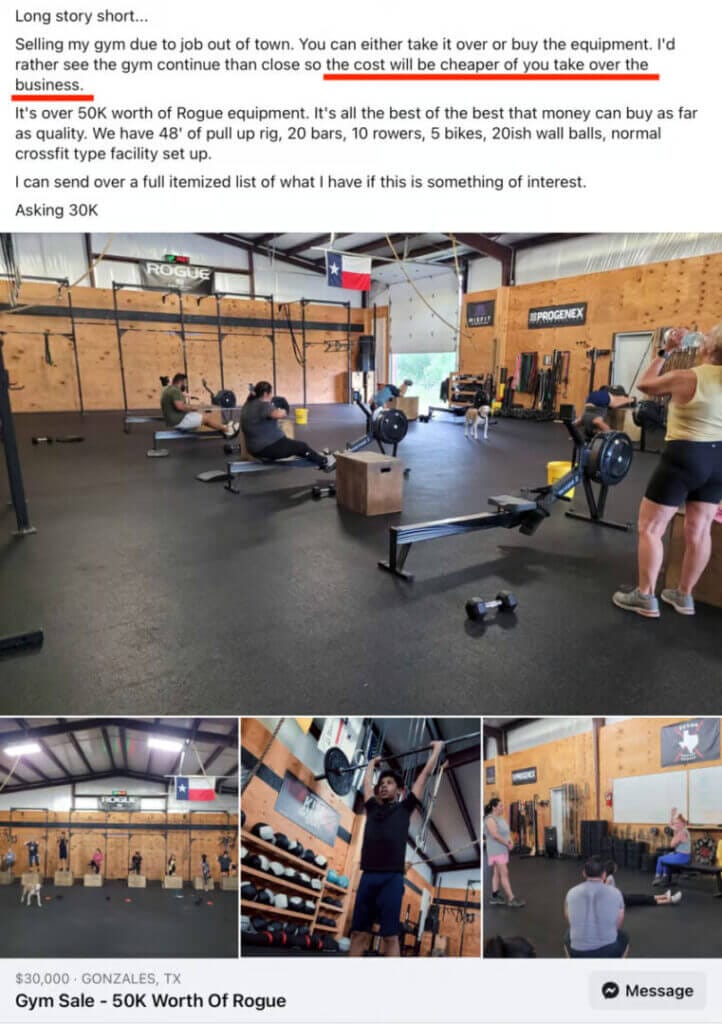And buying 7-figures of real estate to run it.
Happy Friday Gym World,
This week I published the first-ever in-person episode of Gym World with special guest Brian Bott—a gym owner, real estate owner, and maker of hot moms.
I’m going to share how he built a 7-figure business using this exact model and his process of buying 7-figure commercial properties to house his gyms—all in 7 years time.
7-7-7 baby.

Let’s get into it.
Building a 7-figure semi-private training business
90% of Brian’s revenue comes from semi-private training, where up to four members work with a coach at a time.
There are four things I like about this model:
1. Individualized programming for the client
Both of Brian’s gyms were the first in the area to offer customized strength training. This means that all 300ish of his current members have an individual program tailored to their needs.
The journey starts with an initial evaluation where they:
- determine their fitness goals
- set out a workout plan that works for them
- are welcome to book an appointment at any time during business hours
You might think it’s tedious to create, track, and maintain 300 unique programs—and you’re not wrong. It’s a lot of work. But it’s very rare to find this type of flexibility in large group training models.

2. Accountability
Coaches are responsible for the program design process, client results, and client needs.
This creates a high level of accountability that allows Brian to monitor client results and client engagement by coach.
💡 Because each client is “owned” by a coach, fewer clients fall through the cracks. This makes it easier to operate a second location.
Brian has one head coach that manages the coaching experience for each location, and a back-office person that takes care of the “business side.” That’s about it.
3. Flexibility for the client
Brian has a small group starting every 30 minutes throughout his operating hours. This gives his clients a little more flexibility in scheduling vs. the typical group model where classes start every hour.
If a client is running 10-15m behind, they can hop in the next group rather than miss their workout for the day.
4. High Average Revenue per Member (ARM)
Brian charges $400/mo for 2 sessions a week. Data from Two-Brain Business shows that the top coaching gyms in the world average $300/mo per member.
💡 Semi-private training requires less space than group training. Both of Brian’s gym are < 2,800 sq ft. Dan Trink & Kyle Fields from the Fort do over $100k/mo in a 1,200 sq ft space!
Buying a $1.1M building
When Brian opened his second location, he knew he wanted to own the real estate. Here’s how he did that AND minimized his risk:
1. It starts with your lease
Brian negotiated a buyout clause in his lease, which gave him the option to purchase the building for $1.1M anytime during the first 2-years.
This turned out well because he signed his lease pre-COVID before prices skyrocketed.

This is the interior of Brian’s gym.
💡 He also had a right of first refusal (RFR) that started after the 2-year price freeze. If someone else wanted to purchase the property for let’s say $1.5M, Brian had first dibs to match & take that offer.

2. Find a way to get financing
The SBA 7(a) loan program is a great place to start for U.S. small businesses that need capital. You can buy a building up to $5M with 10% down and rent up to 49% of the space to a tenant for increased cash flow.

Another option is to use a private lender, which is a more flexible type of loan than the ones you find at your local bank.
BONUS: how to spot a good location
I’ve bought 5 gyms in my career. Brian asked for my advice when he was looking to open his second location. This is what I told him:
Look for a gym with an absentee owner that is operating around breakeven despite having a bad website/GMB, poor lead nurture, and untrained staff.
At breakeven, a gym is worth less than the assets inside of it because the new owner needs to take on the lease liability.
Because of this, you buy a gym that’s close to cash flowing for less than it’d cost you to open one on your own.
While this gym doesn’t meet all my criteria, you can get a general idea of what’s out there:

This person will sell you his gym for less than the liquidation value of the equipment if you take over the lease.
If you successfully turn the business around (not easy), you can increase your net worth quickly.
Why?
Because a profitable business sells at a multiple of the money the owner takes out of it each year. For gyms, that multiple is usually 2-4x.
So if you can take a gym from $0 in seller earnings to $100k/yr, the value of the business goes from the liquidation value of the equipment to around $200k-$400k.
Hope this helps,
j






